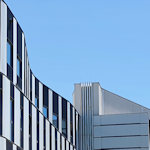
As a recreational area and amusement park, the Prater seems an unlikely place for architectural highlights. And yet it has a few surprises in store: from 18th-century party venues to futuristic urban developments.
- Highlights include:
- The giant ferris wheel
- The national stadium
- The Lusthaus (which once entertained Europe’s emperors)
- The University of Economics and Business campus
- Book a ride on the Riesenrad* ferris wheel
- See also:
Vienna in microcosm

(The ferris wheel remains the landmark most associated with the Prater)
People tend to associate Vienna with palaces and 19th-century museums. A look at the Viennese cityscape, though, reveals plenty of modern architectural action.
The Prater has a similar mix: historical features alongside innovative 21st-century designs. Let me take you through some highlights, which are all marked on the map at the bottom of the post.
In the park
As you might guess from the introduction, most of the Prater is rides, restaurants and other such entertainments. Or woods, water and meadows. Nevertheless, one of two older buildings make an appearance. For example…
The Riesenrad

(An 1897 postcard of the Riesenrad produced by Karl Schwidernoch; note the original design had more wagons than today’s Ferris wheel. Wien Museum Inv.-Nr. 305564; reproduced with permission under the terms of the CC0 licence)
Well, there’s no getting past the Riesenrad in any discussion of Prater architecture. The giant ferris wheel is a friendly face on just about any Viennese skyline and a notable city feature.
First opened in 1897, what you see today largely dates back to 1947; the original burnt down during WWII. Think of the Riesenrad as a timeless constant in the never-ending modernisation of entertainment.
Address: Riesenradplatz 1, 1020 Vienna
Kugelmugel
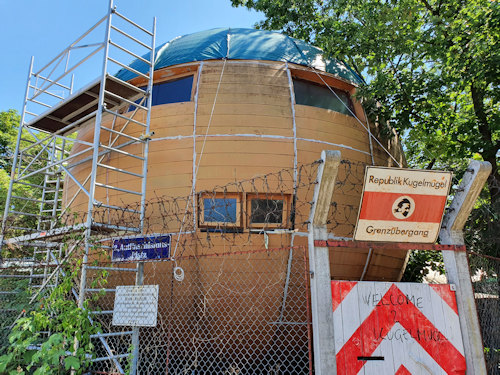
(An unexpected border)
A short walk south of the Riesenrad takes you to a small fenced-in compound containing the self-declared Republic of Kugelmugel with its famous sphere.
The building began life in 1971 as a studio for Edwin Lipburger in Lower Austria. Escalating arguments with the local planning authorities saw Lipburger declare political autonomy, which eventually earned him a jail sentence and then a presidential pardon.
The Kugelmugel continues to serve as an anti-authoritarian symbol of artistic freedom and a venue for art events.
Address: Antifaschismusplatz 2, 1020 Vienna
The Lusthaus
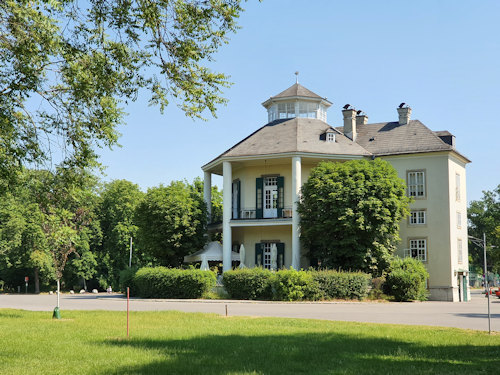
(Once an Imperial summer house, now a restaurant)
The first Lusthaus in the Prater appeared in the mid-1500s (!), when the area served as royal hunting grounds. The current building bearing that name dates back to the 1780s, though much of what you see is reconstruction work following extensive WWII damage (there’s a theme developing here).
The location marks one end of the long Prater Hauptallee boulevard that leads away from the entertainment park, with footpaths and roads branching off to the Donaukanal and Danube.
Lusthaus means a kind of summer house and the building would typically have been used for entertaining and recreation. Various European monarchs (including the Austrian emperor Franz I) celebrated the first anniversary of the 1813 Battle of Leipzig here, for example.
The hospitality tradition continues today through the café-restaurant inside.
Address: Freudenau 254, 1020 Vienna
Kirche Maria Grün
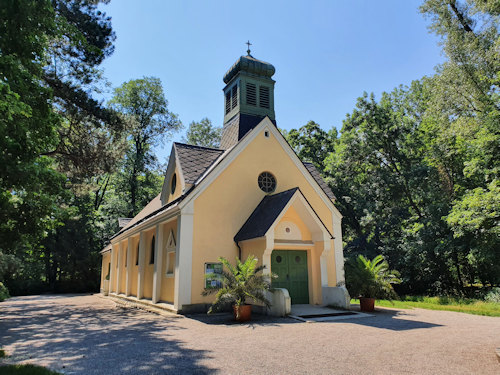
(Hidden among the trees)
Nestled along the hiking trail that takes you around the Prater park is an unobtrusive small Roman Catholic church consecrated in 1924 and dedicated to the Virgin Mary.
The Kirche Maria Grün is notable for its AIDS memorial, and it hosted, for example, an event during the 2019 Vienna Pride.
Address: midpoint of the Aspernallee, 1020 Vienna
Northern edge of the park
The north side of the Prater beyond the park proper offers an intriguing mix of buildings…
Sports stadiums
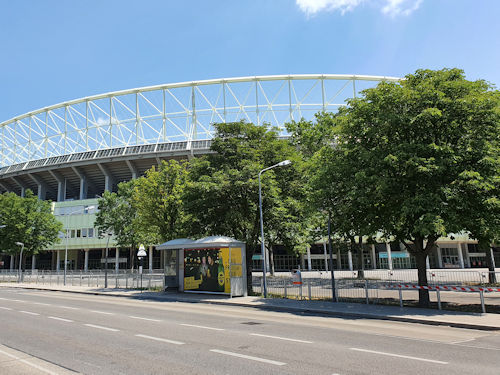
(The Austrian national football team plays most of its home matches here)
For starters, you have the national football stadium, built in 1931 with a current capacity of around 50,000.
Colloquially known as the Prater stadium, the official title is the Ernst Happel stadium (named after the famous Vienna-born football trainer who took Holland to the 1978 World Cup final).
This venerable temple of football has hosted numerous notable matches, including the final of the 2008 European Championships and four European Cup / Champions League finals.
The location also serves as a venue, with appearances by the likes of the Rolling Stones, AC/DC, David Bowie, Michael Jackson, Robbie Williams and even the Pope.
Address: Meiereistraße 7, 1020 Vienna
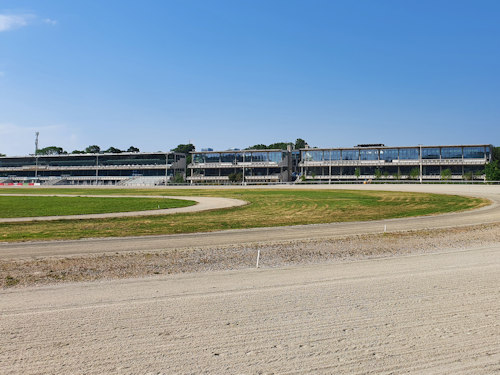
(Horse racing of an unusual kind)
A little west of the big stadium lies a sporting venue of another kind: the Krieau Trabrennpark. This racing track features harness racing (where a horse pulls a two-wheeled vehicle with a driver).
The track dates back to the popularity of carriage driving in the Prater in the late 1800s, with the Krieau facility opening in 1878.
Address: Krieau 245, 1020 Vienna
Places to learn and live
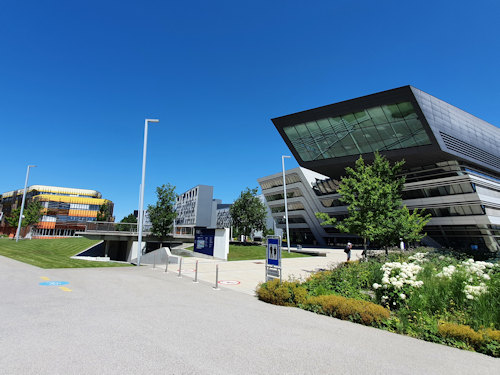
(The library and other buildings of the Wirtschaftsuniversität Wien)
Now we come to probably the most impressive buildings associated with the Prater, beginning with the Wirtschaftsuniversität Wien (Vienna University of Economics and Business).
The university’s new campus, opened in 2013, has become a paradise for photographers thanks to the collection of unique buildings that stretch across around half a kilometer of the edge of the Prater.
It all comes as quite a shock as you emerge from scruffy woodland and snack bars to face something from a futuristic film set.
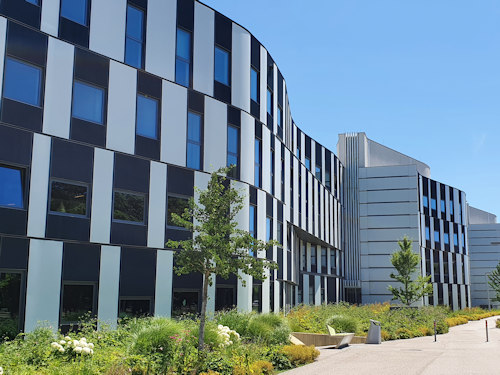
(Part of the Vienna University of Economics and Business)
Top international architects (including the likes of Zaha Hadid) designed the individual buildings, with the whole complex built on principles of ecological, social and economic sustainability.
Address: Welthandelsplatz 1, 1020 Vienna
The innovative architecture continues in the area to the northeast of the university campus and between the campus and the Krieau racing course.
The mix of commercial towers and apartment blocks hits a striking architectural note, contributing to that sense of time travel.
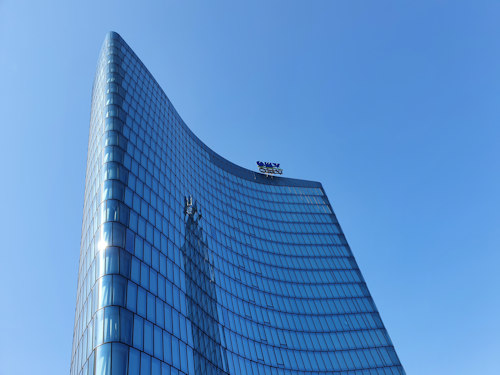
(The headquarters of OMV, a huge energy and chemicals company)
On one side you have centuries-old history, entertainment for the masses, meadows and playgrounds. On the other, futuristic urban developments: best seen by walking from the Krieau subway station (on the U2) down to the Prater.
For more details on what else this area has to offer in terms of food, entertainment, hiking and cycling, take a peek at the Prater overview.